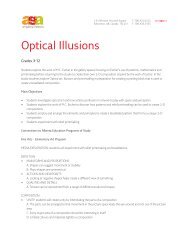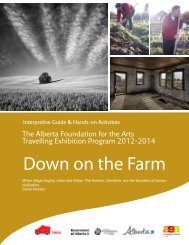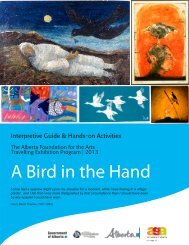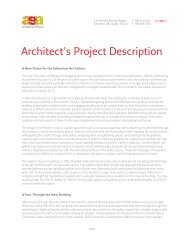Urban Animals - Art Gallery of Alberta
Urban Animals - Art Gallery of Alberta
Urban Animals - Art Gallery of Alberta
Create successful ePaper yourself
Turn your PDF publications into a flip-book with our unique Google optimized e-Paper software.
The <strong>Alberta</strong> Foundation for the <strong>Art</strong>s Travelling Exhibition Program<br />
Animal Studies: Rabbit continued<br />
Rabbits have a very rapid reproductive rate. The<br />
breeding season for most rabbits lasts 9 months, from<br />
February to October. Normal gestation is about 30 days.<br />
The average size <strong>of</strong> the litter varies but is usually between<br />
4 and 12 babies, called kittens or kits. A kit can be weaned<br />
at about 4 to 5 weeks <strong>of</strong> age. This means in one season a<br />
single female rabbit can produce as many as 800 children,<br />
grandchildren, and great-grandchildren. A female rabbit or<br />
doe is ready to breed at about 6 months <strong>of</strong> age and a male<br />
or buck at about 7 months.<br />
Kits are altricial, which means they are born blind, naked, and helpless. Due to the<br />
nutritious nature <strong>of</strong> rabbit milk, kits only need to be nursed for a few minutes once or twice a<br />
day. At 10 to 11 days after birth the baby rabbits’ eyes open and they start eating on their own at<br />
around 14 days old. Although born naked, they form a s<strong>of</strong>t baby coat <strong>of</strong> hair within a few days.<br />
At about 5 to 6 weeks old, the s<strong>of</strong>t baby coat is replaced with a pre-adult coat. A about 6 to 8<br />
months <strong>of</strong> age this intermediate coat is replaced by the final adult coat, which is shed twice a<br />
year there after. The expected lifespan <strong>of</strong> rabbits is about 9 to 12 years.<br />
Mankind uses rabbits in many ways. Domestic<br />
rabbits can be kept as pets in a backyard hutch<br />
indoors. European rabbits and hares are also a food<br />
meat, especially in Europe, South America, North<br />
America and some parts <strong>of</strong> the Middle East. When<br />
used for food rabbits are both hunted and bred.<br />
Rabbit meat is source <strong>of</strong> high quality protein. It can be<br />
used in most ways chicken meat is used. Rabbit meat<br />
is also leaner than beef, pork, and chicken meat.<br />
Rabbit pelts are sometimes used for clothing and<br />
accessories, such as scarves or hats.<br />
Rabbits are also very good producers <strong>of</strong> manure. Additionally, their urine, high in nitrogen,<br />
makes some tree species, such as lemon trees, very productive. Despite their uses, however,<br />
rabbits have also been a source <strong>of</strong> environmental problems. As a result <strong>of</strong> their appetites, and<br />
the rate at which they breed, feral rabbit depredation can be problematic for agriculture.<br />
Rabbits appear in the culture and literature <strong>of</strong> many civilizations. Rabbits are <strong>of</strong>ten used as<br />
a symbol <strong>of</strong> fertility or rebirth, and have long been associated with spring and Easter as the<br />
Easter bunny. The species’ role as a prey animal also lends itself as a symbol <strong>of</strong> innocence,<br />
another Easter connotation. Additionally rabbits are <strong>of</strong>ten used as symbols <strong>of</strong> playful sexuality<br />
due to its reputation as a prolific breeder.<br />
The rabbit <strong>of</strong>ten appears in folklore as the trickster archetype as he uses his cunning to<br />
outwit his enemies. As a trickster he appears in American popular culture in the character <strong>of</strong><br />
Br’er Rabbit from African-American folktales and Disney animation; and the Warner Bros.<br />
cartoon character Bugs Bunny. Anthropomorphized rabbits appear in such works as Lewis<br />
Carroll’s Alice’s Adventures in Wonderland and the novels Watership Down by Richard Adams.<br />
AFA Travelling Exhibition Program, Edmonton, AB. Ph: 780.428.3830 Fax: 780.421.0479<br />
youraga.ca

















